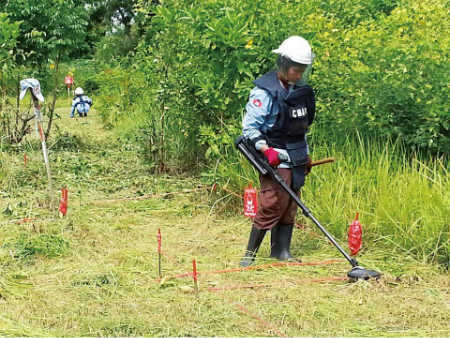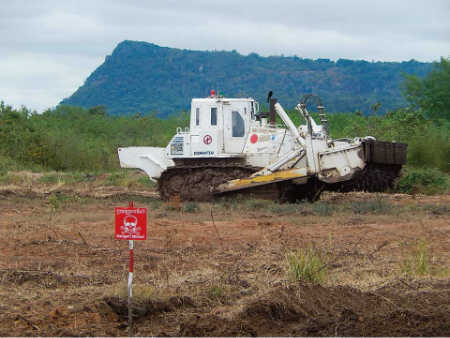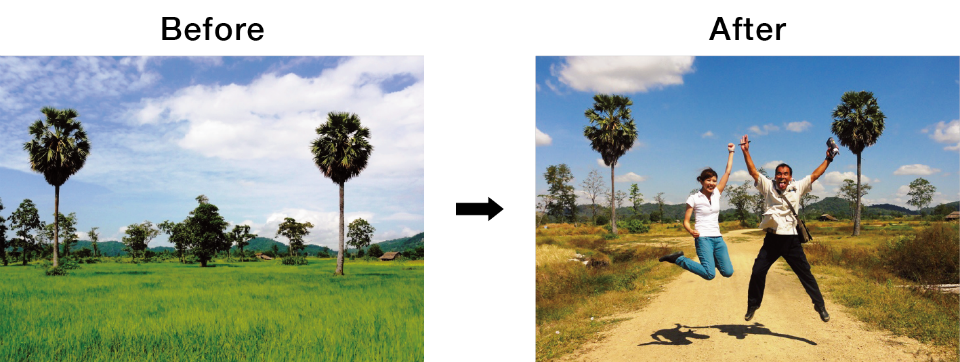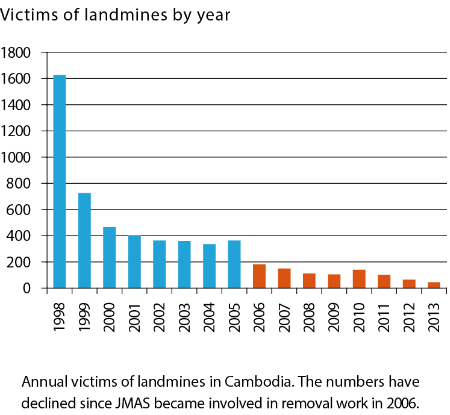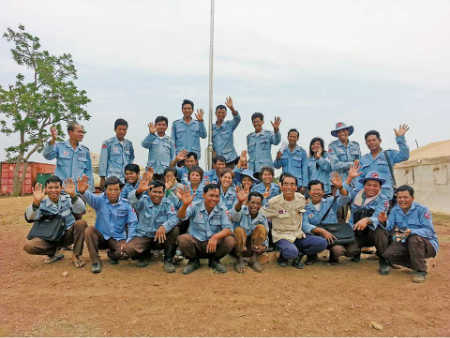“Thank goodness we weren’t too late.” Yohei Imai says he feels this sense of relief each time his crew disposes of a landmine from the Cambodian soil.
Underlying this is a memory from shortly after he was posted to Cambodia, when a tractor trailer struck a mine near the area where he was working, killing an entire family of 14. “It grieved me terribly that a single mine was able to wipe away the smiling faces of an entire family and rob them of their future.” he explains. “My sense of relief each time comes from knowing that we managed to remove one more of these potential sources of tragedy.”
Upon retiring at the mandatory age of 55 from the Japan Ground Self-Defense Force (JGSDF), Imai joined the Japan Mine Action Service (JMAS), a nonprofit organization, at the invitation of a former superior officer. “I had the vague idea that I’d like to work overseas doing something that would benefit others,” he explains, “and when I heard about JMAS, where I could utilize the civil engineering and landmine removal skills I acquired while in the JGSDF, I eagerly applied.” A mere four days after his retirement, Imai arrived in Cambodia, where some four to six million landmines remained in the ground after the country’s long and bitter civil war and have claimed around 60,000 victims. Imai was posted to Battambang Province, one of the most mine-affected regions.
It is Imai’s job to improve the capabilities of local demining crew members. This involves training them how to perform all the stages of manual removal, from detection to detonation, as well as teaching them how to operate mine-clearing equipment. He and a colleague provide classroom and field training to 60 Cambodian crew members. It is a tough job, conducted in scorching heat with danger as a constant companion.
Imai says there are times in the field when his heart skips a beat. “We don’t have the same level of removal equipment and protective gear as in Japan,” he says. “So I’m all the more rigorous in teaching the staff to observe safety measures, including careful preparation and proper removal techniques.”
Initially, Imai and his colleague had some trouble with the relaxed attitudes of Cambodian crew members. They tended not to be punctual and would fail to put equipment away after use. Aware that even minor breaches like these could lead to sloppiness in safety measures, they started by teaching the crew to be tidy in the field.
Providing positive feedback to crew members was an important aspect of training. Imai explains: “For example, if the mine markers or minefield boundaries lined up straight, I’d tell them, ‘You did a great job.’ I’d also offer words of praise like ‘You’re earlier than yesterday.’ It doesn’t matter whether you’re Cambodian or Japanese; all humans respond to positive reinforcement. After a few weeks they were all keeping their working areas tidy on their own initiative.”
So far Imai has overseen the removal of 300 mines without a single accident. This is a rewarding accomplishment in terms of increasing the number of paths people can walk safely, and it is also indicative of his success in transmitting the necessary skills to the crew.
One job Imai fondly recalls involved demining a rice paddy where two palm trees remained standing. “The area was thick with mines and took several months to clear,” he explains. “When that was done, we put in a new road and installed irrigation canals. The area became lush with rice plants. And when a farmer came and said, ‘Thank you. This is the first rice we harvested here,’ and handed it to me, I was quite touched.”
It was Imai’s idea to build the road so that it passed directly between the two palm trees. It is a long road, free of the terror of landmines. Adults take it on their way to work and children on their way to school. Imai calls it the “road of hope.”
A mine clearing vehicle donated by a Japanese construction equipment manufacturer detonates antipersonnel mines.
Mayumi Narazaki (center) is a JOCV with intellectual disability assigned to the non-
The “road of hope” constructed under Imai’s direction through an area cleared by his crew.
Yohei Imai
(Front row, in white, fourth from the right.)
Born in 1955 in Gunma Prefecture. Entered the JGSDF in 1971. Retired in 2010 after serving as chief of the northern area of the JSDF Asahikawa Provincial Cooperation Office. Joined JMAS the same year. Currently active in Cambodia as an expert in landmine removal.































































































































